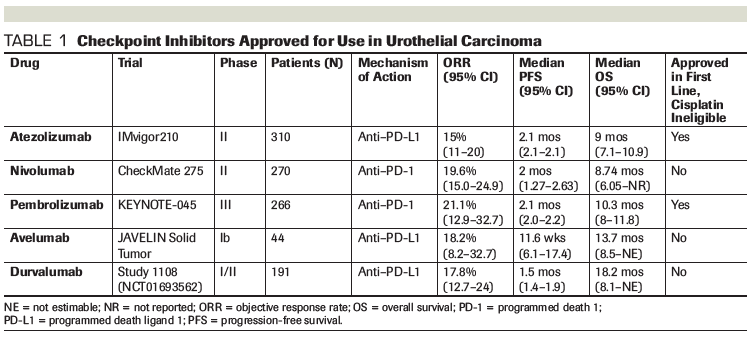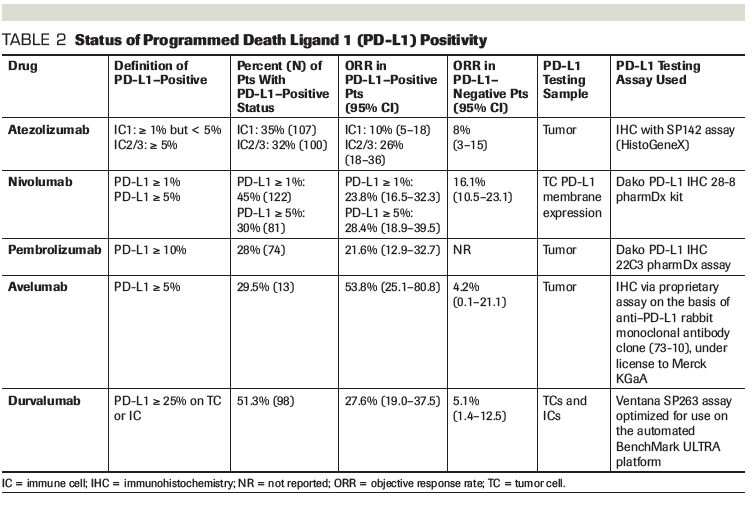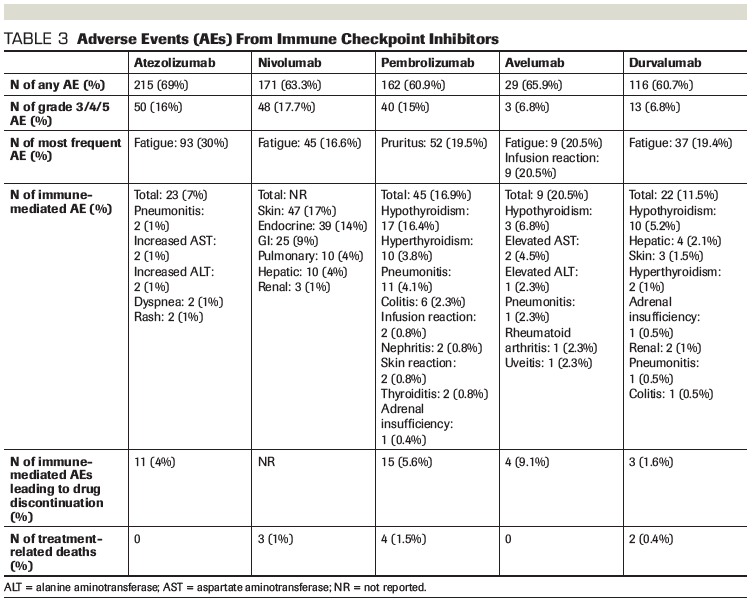Current and Future Landscape of Immune Checkpoint Inhibitors in Urothelial Cancer
In this review, we discuss known data and the differences between the different immune checkpoint inhibitors, as well as future avenues to explore with immuno-oncologic agents in urothelial cancer.
Oncology (Williston Park). 33(1):11-8.

Omar Alhalabi, MD

Amishi Y. Shah, MD

Emily A. Lemke, DNP, AGPCNP-BC, AOCNP

Jianjun Gao, MD, PhD

Table 1. Checkpoint Inhibitors Approved for Use in Urothelial Carcinoma

Table 2. Status of Programmed Death Ligand 1 (PD-L1) Positivity

Table 3. Adverse Events (AEs) From Immune Checkpoint Inhibitors

Programmed cell death 1 immune checkpoint protein bound to a programmed death ligand 1 protein.

Immune checkpoint inhibitors have revolutionized the field of oncology, providing a novel mechanism for anticancer therapy. Programmed death 1–targeting antibodies pembrolizumab and nivolumab and programmed death ligand 1 (PD-L1)–targeting antibodies atezolizumab, durvalumab, and avelumab have been approved for use in advanced urothelial cancer in the post-platinum setting or in the upfront setting in platinum-ineligible patients. While this represents a significant step forward in management of urothelial cancers, most patients do not have an objective response to these therapies. PD-L1 expression is not a consistently predictive biomarker, but is recommended for checkpoint utilization in select circumstances. We report here a summary of known data and the differences between these agents, as well as future avenues to explore with immuno-oncologic agents in urothelial cancer. Much work is ongoing to better understand resistance mechanisms, to maximize efficacy with combination strategies, to find improved predictive biomarkers, to assess curative-intent strategies, and to better manage toxicity with these agents.
Introduction
Bladder cancer (synonymously referred to as urothelial carcinoma) is the 4th most common cancer occurring in men and the 12th in women, with an estimated US incidence of 81,190 cases and an estimated 17,240 deaths in 2018.[1] While 75% of new urothelial cancer cases are non–muscle-invasive, 25% are muscle-invasive or metastatic at presentation.[2] Traditionally, outcomes have been poor in metastatic disease, with a 5-year survival rate of 4.8% in the distant metastatic setting, compared with 68% for localized disease.[3] Prior to the development of immunotherapies, the median overall survival (OS) for metastatic urothelial cancer patients was 13.8 to 15.5 months when using standard-of-care platinum-based therapies.[2,4] For those who are ineligible for treatment with cisplatin, carboplatin-based regimens are available and provide modest activity, with an historic median OS of approximately 9 months.[5] Following platinum chemotherapies, patients who receive second-line chemotherapies have a lower median OS of approximately 7 months.[6,7] The past few years have brought the introduction of immune checkpoint inhibitors, which have led to an upsurge in effective treatments for previously refractory metastatic cancers.[8]
Cancer Immune Response and Checkpoint Inhibition
Antitumor immunity is dependent on a complex series of events that involve antigen presentation, lymphocyte activation and proliferation, recruitment to the tumor microenvironment, and, finally, execution of cancer-killing functions. T-lymphocyte activation requires the engagement of the T-cell receptor with the major histocompatibility complex on antigen-presenting cells. Normally, activation requires a co-stimulatory signal from CD28 binding with B7-1 (CD80) or B7-2 (CD86).[9,10] In addition to these activating interactions, several co-inhibitory receptors (checkpoints) have been described. The cytotoxic T-lymphocyte–associated antigen 4 (CTLA-4) and programmed death 1 (PD-1) pathways currently have the most data. The CTLA-4 protein on activated T cells can take the place of CD28 to bind its ligand B7 proteins and result in T-cell inhibition. The PD-1 protein on activated T cells binds to programmed death ligand 1 (PD-L1) on normal or cancerous cells, leading to a downregulation of T-cell response. Immune checkpoint inhibitors interfere with CTLA-4/B7 or PD-1/PD-L1 interaction and result in augmented T-cell activation for antitumor response.
Thomas Flaig, MD
An Optimistic Time for Patients With Advanced Urothelial Carcinoma
Immune checkpoint inhibitors have substantially impacted the treatment of metastatic urothelial carcinoma, as very well outlined in the review article by Alhalabi et al. We should celebrate the US Food and Drug Administration’s approval of five new agents in this setting. Despite this clear progress, however, it is apparent that there is still a great unmet clinical need. The current response rate to therapy in urothelial carcinoma remains low, even in biomarker-selected populations.
Two main approaches can increase patient response to these agents: combination therapy with other immune modulators or the addition of immune checkpoint inhibitors to cytotoxic/targeted agents, as well as better patient selection. Many trials examining combination treatments in urothelial carcinoma are currently underway. One challenge resulting from the dramatic increase in the number of agents available in this setting is completing the large number of active trials. Regrettably, the development of biomarkers for these agents has been individualized to each drug, with different assays and thresholds. This makes it difficult to define the best approach to utilize predictive biomarkers in urothelial carcinoma and to gain generalizable knowledge to advance the field. Other emerging biomarker approaches, including tumor mutational burden and molecular subtypes, may provide additional information to improve patient selection.
In many ways, this is an optimistic time for patients with advanced urothelial carcinoma. Compared with just a few years ago, we are now in a much stronger position in terms of improving medical treatment options. Today, we are now concerned about successful trial completion-not because of poor general accrual/pharmaceutical engagement, but due to the high number of trials and promising agents. To benefit patients and to continue to maximize clinical benefit, we need to find ways to share data, and even samples, from past and future trials. Doing so will help us reach our goals of improving our basic understanding of advanced urothelial carcinoma, thereby establishing a consensus on the use of predictive biomarkers in this realm.
Financial Disclosure: Dr. Flaig receives clinical trial support from Agensys, Astellas, AstraZeneca, Bristol-Myers Squibb, Janssen, Merck, Pfizer, Roche/Genentech, and Seattle Genetics. He is also a founder and holds intellectual property for Aurora Oncology.
Dr. Flaig is Chief Clinical Research Officer at UCHealth and the Associate Dean for Clinical Research at the University of Colorado School of Medicine in Aurora, Colorado.
Immune Checkpoint Inhibitors for Metastatic Urothelial Carcinoma After Frontline Platinum Therapy
Two monoclonal antibodies targeting PD-1 (nivolumab and pembrolizumab) and three antibodies targeting PD-L1 (atezolizumab, avelumab, and durvalumab) have changed the treatment landscape of metastatic urothelial carcinoma. Table 1 has further details on outcomes with each of these immune checkpoint inhibitors. These agents have demonstrated clinical activity following platinum-containing chemotherapies in metastatic urothelial carcinoma, with objective response rates (ORRs) ranging from 15% to 25%.[11-16] Of note, investigators have historically relied on Response Evaluation Criteria in Solid Tumors (RECIST) to evaluate antitumor responses to chemotherapeutic agents. However, the responses that are seen with immunotherapeutic agents may extend beyond those of cytotoxic agents and could include responses that are not captured by RECIST. The immune-related response criteria (irRC) can better capture the response patterns for immunotherapeutic agents.[17]
Atezolizumab
Atezolizumab is an anti–PD-L1 monoclonal antibody and was the first immune checkpoint inhibitor to be approved by the US Food and Drug Administration (FDA) for locally advanced or metastatic urothelial carcinoma patients who progressed during or after platinum therapy. In a large phase I trial that enrolled 68 patients with previously treated disease, atezolizumab had an ORR ranging from 11% to 43%.[15] The higher ORR was seen in tumors expressing high levels of PD-L1, defined as ≥ 5% on tumor cells or tumor-infiltrating immune cells. These exciting results led to the IMvigor210 trial, a phase II trial that included two cohorts (previously treated and treatment-naive patients). PD-L1 expression on immune cells determined stratification of patients with the following thresholds: IC0 (< 1%), IC1 (≥ 1% but < 5%), and IC2/3 (≥ 5%). The ORR to second-line cytotoxic chemotherapy in all-comers was 15% vs 10% in historical controls. However, higher IC score led to higher response, with an ORR of 18% for IC1/2/3 and 27% for IC2/3.[13] This provided the basis for the FDA to approve atezolizumab in May 2016.
IMvigor211 followed IMvigor210 and randomized patients who progressed after platinum therapy to receive either atezolizumab or chemotherapy (physician’s choice between taxanes or vinflunine). Similarly to IMvigor210, PD-L1 on immune cells was used to stratify patients. The primary endpoint of OS was tested in hierarchical fashion: first in the IC2/3 population, followed by the IC1/2/3 population, and then the intention-to-treat population. The IC2/3 population failed to show improved survival; therefore, the other populations were not evaluated.[18]
Avelumab
Avelumab is a fully human anti–PD-L1 monoclonal antibody that has the additional ability to lyse PD-L1–expressing tumor cells by antibody-dependent cell-mediated cytotoxicity.[19] In a phase Ib trial, avelumab showed an ORR of 18.2% in post-platinum metastatic urothelial carcinoma, with a tolerable safety profile (grade 3/4 adverse events, 6.8%). In a pooled analysis of two cohorts (both post-platinum therapy and cisplatin-naive) from the phase I dose-expansion JAVELIN Solid Tumor study, avelumab showed a similar safety profile to the phase Ib data. Antitumor activity was analyzed in the post-platinum cohort and demonstrated an ORR of 17%. Patients in the JAVELIN trial were not selected based on PD-L1 expression.
The ongoing phase III JAVELIN Bladder 100 trial (ClinicalTrials.gov identifier: NCT02603432) is examining avelumab as a maintenance therapy in patients with locally advanced or metastatic urothelial cancer whose disease did not progress after completion of first-line platinum-containing chemotherapy. GCISAVE (NCT03324282) is a study that will assess the efficacy and safety of the combination of gemcitabine, cisplatin, and avelumab in the first-line treatment of locally advanced or metastatic urothelial carcinoma patients.
Durvalumab
Durvalumab, another anti–PD-L1 monoclonal antibody, was evaluated in a phase I trial and showed an ORR of 46.4% in a PD-L1–positive (defined as ≥ 25% on tumor cells or tumor-infiltrating immune cells) subgroup and 0% in a PD-L1–negative subgroup.[20] These results were further assessed in a phase I/II trial of metastatic urothelial carcinoma patients who progressed on, were ineligible for, or refused prior chemotherapy. The majority (95.3%) of enrolled patients had failed platinum therapy. The ORR was 17.8% across all patients.[12] In May 2017, based on these results, the FDA granted accelerated approval for the use of durvalumab in the second-line setting for metastatic urothelial cancer refractory to first-line cisplatin-based chemotherapy.
Nivolumab
Nivolumab is an anti–PD-1 monoclonal antibody that was first assessed in CheckMate 032, a phase I/II single-arm trial. It showed an ORR of 24.4% in patients with locally advanced or metastatic urothelial cancer who progressed after platinum-based therapy. When stratified by PD-L1 expression, the response rate was similar for the PD-L1–high (≥ 1% on tumor cells) and PD-L1–low (< 1% on tumor cells) groups (24% vs 26%). However, median OS was 16.2 months for PD-L1–high patients compared with 9.9 months in the PD-L1–low group.[14]
The phase II single-arm CheckMate 275 trial followed, which evaluated nivolumab for metastatic disease after platinum therapy.[21] The primary endpoint was ORR by tumor PD-L1 expression (both ≥ 5% and ≥ 1%) and ORR in all treated patients. The ORR was 19% for all patients, regardless of PD-L1 expression. However, when analyzed by PD-L1 expression, the ORR was 28.4% when PD-L1 expression was ≥ 5%, 23.8% when PD-L1 expression was ≥ 1%, and 16.1% when PD-L1 expression was < 1%. Nivolumab was well tolerated, with only 18% of patients experiencing grade 3/4 adverse events. Based on these results, in February 2017, the FDA granted approval to nivolumab for second-line use in metastatic urothelial carcinoma patients following progression on cisplatin therapy.
Pembrolizumab
Pembrolizumab is an anti–PD-1 monoclonal antibody that was studied in the phase Ib KEYNOTE-012 trial.[22] This study required at least 1% PD-L1 expression detected on the tumor cells or in tumor stroma, as determined by immunohistochemistry. Overall response was achieved in 26% of patients. Grade 3 adverse events occurred in 15% of patients. Following KEYNOTE-012, KEYNOTE-045 was a phase III trial that investigated pembrolizumab in patients with metastatic urothelial carcinoma that recurred or progressed after platinum-based chemotherapy.[23] Patients received either pembrolizumab at 200 mg every 3 weeks or the investigator’s choice of chemotherapy with docetaxel, paclitaxel, or vinflunine.
In this trial, the concept of combined positive score (CPS) was used after being introduced in the KEYNOTE-052 trial.[24] CPS is defined as the percentage of PD-L1–expressing tumor cells and infiltrating immune cells relative to the total number of tumor cells. The OS was longer for the pembrolizumab group vs the chemotherapy group for all patients (10.3 vs 7.4 months) and for those with CPS ≥ 10% (8.0 vs 5.2 months). The ORR was 21% for pembrolizumab vs 11% for chemotherapy. Based on these results, in May 2017, the FDA approved pembrolizumab for patients with metastatic urothelial cancer who have disease progression during or following platinum-containing chemotherapy or within 12 months of neoadjuvant or adjuvant treatment with platinum-containing chemotherapy.
Immune Checkpoint Inhibitors for Metastatic Urothelial Carcinoma in the Frontline Setting
Atezolizumab
Cohort 1 of the IMvigor210 trial used atezolizumab in treatment-naive metastatic urothelial carcinoma patients who were ineligible for treatment with cisplatin.[25] Stratification was again based on PD-L1 expression (IC0, IC1, and IC2/3). The ORR in all patients was 23%, and in contrast to prior results, the ORR did not correlate with PD-L1 expression. In April 2017, the FDA accelerated the approval of atezolizumab for the first-line treatment of cisplatin-ineligible patients with metastatic disease.
IMvigor130 is an ongoing phase III trial to further study the treatment-naive cohort, but it was amended to include all platinum-eligible patients. It is randomizing patients to three arms: atezolizumab and platinum-based chemotherapy, atezolizumab alone, or chemotherapy alone. Stratification is similar to the IMvigor210 and IMvigor211 trials. In June of this year, the FDA announced that treatment-naive patients with low PD-L1 status (IC0/1) have a lower OS with the use of atezolizumab monotherapy compared with platinum-based chemotherapy alone. Therefore, the FDA revised the indication label for atezolizumab to include cisplatin-ineligible patients, as long as they are categorized as IC2/3 as determined by an FDA-approved test. However, if patients are cisplatin and carboplatin ineligible, then atezolizumab is still indicated regardless of PD-L1 status. The FDA has not changed the indications for disease progression during or following any platinum-containing chemotherapy, or within 12 months of neoadjuvant or adjuvant treatment.
Pembrolizumab
The phase II KEYNOTE-052 trial studied pembrolizumab as first-line treatment for 370 cisplatin-ineligible patients with metastatic urothelial carcinoma.[24] There was a 24% ORR in all patients who received at least one dose of pembrolizumab. The ORR was higher-38%-in patients with a CPS of 10% or more. The ongoing phase III KEYNOTE-361 trial (NCT02853305) is randomizing treatment-naive metastatic urothelial cancer patients 1:1:1 to receive pembrolizumab, pembrolizumab plus investigator’s choice of chemotherapy (containing cisplatin), or chemotherapy alone. Patients who are cisplatin-ineligible are randomized to a carboplatin-based regimen. In June, the FDA announced that treatment-naive patients with a low CPS (< 10%) have a lower OS with the use of pembrolizumab monotherapy compared with platinum-based chemotherapy alone. Therefore, the FDA revised the indication label for pembrolizumab to include cisplatin
-ineligible patients, as long as they have a CPS ≥ 10% by an FDA-approved test. In fact, the data monitoring committee for the IMvigor130 and the KEYNOTE-361 trials stopped enrolling patients with PD-L1–low status to the immunotherapy-only arms. Similar to atezolizumab, if patients are ineligible for cisplatin and carboplatin, then pembrolizumab is still indicated regardless of PD-L1 status. The FDA has not changed the indications for disease progression during or following any platinum-containing chemotherapy, or within 12 months of neoadjuvant or adjuvant treatment.
Predictive Biomarkers for Response and Resistance to Immune Checkpoint Inhibitors
Blocking the PD-1 checkpoint or its ligand PD-L1 has revolutionized the management of patients with metastatic urothelial carcinoma. However, a large majority of patients do not respond to these agents. Consequently, there have been several efforts to identify biomarkers to predict response and tackle this challenge.
PD-L1 as a prognostic and predictive marker
Early experiments showed PD-L1 expression in urothelial cancer to be associated with a higher grade of tumor,[26] worse clinical outcomes, and decreased postoperative survival.[27] Therefore, it seemed obvious to use it as a predictive biomarker for patient selection. However, as previously mentioned and outlined further in Table 2, PD-L1 status is not always predictive of response. In the IMvigor210 trial, a higher score for PD-L1 expression was associated with a higher response rate.[13] In contrast, the CheckMate 275 trial showed clinically meaningful responses to nivolumab irrespective of PD-L1 expression.[21] Several explanations for this discrepancy exist. First, staining and interpreting PD-L1 expression by immunohistochemistry assays is not yet reproducible. For example, the IMvigor210 trial used the Ventana PD-L1 (SP142) assay to measure PD-L1 on tumor-infiltrating immune cells, the durvalumab trial utilized the Ventana PD-L1 (SP263) assay to measure PD-L1 on both tumor cells and immune cells, and the CheckMate 275 trial used the Dako PD-L1 28-8 pharmDx kit to measure PD-L1 on tumor cells only.[13,20,21] Second, the percentage cutoffs used to define high and low expression were not uniform. Third, PD-L1 expression is dynamic, and a single biopsy is unlikely to provide a complete assessment of status for the entire duration of disease.
Tumor interferon-γ signaling correlates to response/resistance to immune checkpoint inhibition
In the aforementioned CheckMate 275 trial, higher values of the 25-gene interferon-γ (IFN-γ) signature were associated with a greater proportion of responders to nivolumab and higher PD-L1 expression.[21] Genomic defects in IFN-γ pathway genes have been described in patients who do not respond to anti–CTLA-4 treatment.[28] Anti–PD-1 therapy in melanoma was reported to induce JAK1 and JAK2 truncating mutations, a genomic evolution that would lead to PD-1 resistance.[29] This is thought to be due to ineffective IFN-γ signaling and insensitivity to its antiproliferative effects on cancer cells. Some proposed that these mutations result in lack of reactive PD-L1 expression and response to IFN-γ.[30,31] In a CRISPR-Cas9 screening effort to identify the genes essential for the tumor effector function of T cells, APLNR gene mutations were found in melanoma tumors refractory to PD-1 blockade.[32] Again, APLNR interaction with JAK1 was essential for IFN-γ responses. These data collectively suggest that tumor IFN-γ pathway signaling deficiency predicts both primary and secondary resistance to immune checkpoint inhibitor therapy.
Transforming growth factor à attenuates tumor response to PD-L1 blockade
The role of transforming growth factor à (TGFÃ) in the tumor microenvironment is complex. High preoperative plasma levels of TGFÃ1 are associated with poor clinical outcomes in patients with urothelial carcinoma.[33] In addition, decreased expression of TGFà receptor 1 in bladder cancer biopsies is associated with poor prognosis.[34] Tumor samples from the IMvigor210 trial, studied by RNA sequencing, showed that TGFà attenuates tumor response to PD-L1 blockade by contributing to exclusion of T cells.[35]
Tumor mutational burden in urothelial carcinoma
An exploratory subgroup analysis of cohort 2 of the IMvigor210 trial that evaluated 315 cancer-related genes showed a significant increase in mutation load in responding patients relative to non-responding patients (12.4 per megabase vs 6.4 per megabase).[13] Smoking status and the Cancer Genome Atlas (TCGA) subtype did not correlate with mutational burden, suggesting that it may be a more reliable predictor of response to PD-L1 blockade in urothelial cancer. Significant challenges confront the use of tumor mutational burden as a predictive biomarker for immunotherapy. First is the challenge of unifying and standardizing the definition of mutation burden relative to the depth of sequencing performed. Second, targeted sequencing panels may not adequately cover gene fusions, truncations, and translocations. Third, germline variants may not be silenced by informatics techniques that filter common germline single-nucleotide polymorphisms.
Clustering by TCGA subtype
Other possible biomarkers include the four microRNA subtype clusters I–IV (luminal I, luminal II, basal I, and basal II) elucidated by the TCGA project.[36] In cohort 2 of IMvigor210, responses to atezolizumab were higher in the luminal cluster II subtype.[13] A similar trend was noted in cohort 1 as well. By contrast, the CheckMate 275 study showed basal I subtype tumors to have higher ORRs.[21] These discrepancies might be related to two factors. First, both IMvigor210 and CheckMate 275 allowed biopsy specimens from the primary tumor, lymph nodes, or metastatic lesions for TCGA subtyping, which may lead to inappropriate tumor classification. Second, the criteria for molecular subtyping differs in each study, highlighting a challenge in standardizing TCGA classification. Until further details emerge, TCGA subtype is not likely to prove to be a strong predictive biomarker for immunotherapy at this time.
CTLA-4 Blockade in Urothelial Cancer
Ipilimumab is an anti–CTLA-4 monoclonal antibody that has been tested in urothelial cancer. In a clinical trial at MD Anderson Cancer Center, 12 patients with localized disease received 2 doses of ipilimumab prior to undergoing cystectomy. Six patients received 3 mg/kg/dose and were analyzed for safety before 6 additional patients were enrolled to receive 10 mg/kg/dose.[37,38] Eight out of 12 patients were found to have a lower stage of disease on their surgical specimen, and 4 out of 12 had a change from positive urine cytology and/or fluorescence in situ hybridization (FISH) analysis to negative urine cytology and/or FISH. Despite the limitations, these data suggest that CTLA-4 blockade leads to a therapeutic effect in urothelial cancer. There are several ongoing efforts to combine CTLA-4 blockade with PD-1/PD-L1 blockade. DANUBE (NCT02516241), a phase III trial of durvalumab monotherapy vs combination durvalumab and tremelimumab (an anti–CTLA-4) vs standard-of-care chemotherapy in patients with stage IV unresectable urothelial cancer, is investigating this possibility.
Recognizing and Managing Toxicity From Immune Checkpoint Inhibitors
Most of the adverse events experienced by patients receiving checkpoint inhibitors (immune-related adverse events [irAEs]) are inflammatory in nature and usually occur during the first 3 months of therapy.[39] Table 3 summarizes the common irAEs, which include hypophysitis, pneumonitis, hepatitis, colitis, dermatitis, and other less common conditions. The types of irAEs also vary with the type of checkpoint inhibitor. For example, PD-1 inhibitors are associated with higher rates of pneumonitis; conversely, diarrhea/colitis is a more common complaint in patients receiving therapy with a CTLA-4 inhibitor. The combination of PD-1 and CTLA-4 inhibitors has led to higher rates of grade 3/4 toxicity. There are minimal published data on irAEs from combination immune checkpoint inhibitor treatment in urothelial cancer. However, in melanoma, a phase III trial using the combination of nivolumab and ipilimumab showed grade 3 or higher toxicity at a rate of 55%.[40] Similar frequency was noted in renal cell carcinoma, at 46%.[41] Because many of these toxicities can present subtly but then become refractory to treatment, cancer care providers are urged to take detailed histories and have a low threshold to work up and treat immune checkpoint inhibitor–mediated events.
Immune Checkpoint Inhibitors in Upper Tract Urothelial Cancer
Upper tract urothelial carcinoma (UTUC) makes up roughly 5% of all urothelial carcinomas.[42,43] UTUCs are reported to have higher frequencies of mutations in mismatch repair genes, resulting in higher microsatellite instability (MSI).[44,45] This includes patients with both germline and somatic mutations, potentially representing up to 30% of the total UTUC population. It is recommended that patients with UTUC be screened for MSI. In a colon cancer study, there was an ORR of 71% with pembrolizumab in a cohort of seven patients with high MSI from tumors other than colon tumors.[46] Although the response rate is not defined for immune checkpoint inhibitors in patients with UTUC, most patients should be considered for treatment with these agents after platinum failure, given the excellent tolerance and potential for durable response.
Immune Checkpoint Inhibitor Trials in the Nonmetastatic Setting
CheckMate 274 (NCT02632409) is a randomized phase III trial comparing adjuvant treatment with nivolumab vs placebo in patients with high-risk invasive urothelial carcinoma of the bladder, ureter, or renal pelvis post-surgery. This trial is currently recruiting and is anticipated to complete in 2020. The AMBASSADOR trial (NCT03244384) is a randomized phase III trial comparing adjuvant treatment with pembrolizumab vs observation in patients with stage II or III bladder cancer following radical cystectomy with pelvic lymph node dissection. This trial is currently recruiting and is anticipated to complete enrollment in 2019. An ongoing presurgical study at MD Anderson Cancer Center (NCT02812420) is evaluating durvalumab plus tremelimumab in patients with high-risk muscle-invasive urothelial carcinoma who are ineligible for cisplatin-based neoadjuvant chemotherapy.
Novel Immunotherapies in Urothelial Cancer
Although the results of recent trials have been encouraging, objective responses with immune checkpoint inhibitors are low, and more than 75% of patients do not respond. Combining two of these agents may improve response rates. The previously mentioned DANUBE trial is an ongoing attempt at this strategy. Combinations of immuno-oncologic agents with other agents that target the immune microenvironment, such as the IDO inhibitor epacadostat, may have synergy and increase response rates. This possibility is being investigated in KEYNOTE-698/ECHO-303 (NCT03374488), a randomized phase III study of pembrolizumab and epacadostat vs pembrolizumab and placebo in metastatic urothelial carcinoma patients in the second-line setting.
It should be noted that it is not likely that immune checkpoint inhibitors will replace the current standard-of-care chemotherapy, but rather augment it. Currently, IMvigor130 and KEYNOTE-361 are addressing whether combination immunochemotherapy will be more effective than immunotherapy alone. Interestingly, cohort 2 of the IMvigor210 study demonstrated that high PD-L1 expression corresponded with a higher ORR, while in cohort 1 there was no correlation between PD-L1 expression and ORR. The major difference between cohorts was the exposure of cohort 1 patients to chemotherapy prior to receiving atezolizumab.[13] This suggests that prior chemotherapy can modulate the immune microenvironment and expression of PD-L1. Indeed, a recent retrospective study demonstrated that PD-L1 expression was significantly higher on post–neoadjuvant chemotherapy specimens than on matched pre–neoadjuvant chemotherapy specimens, supporting this premise.[47]
M7824 is a novel first-in-class bifunctional fusion protein consisting of the extracellular domain of the TGFÃ receptor 2, which functions as a “trap” for all three TGFÃ isoforms, covalently linked to the C-terminus of the heavy chain of the anti–PD-L1 antibody derived from avelumab.[48] Preliminary data from a phase I dose-escalation study suggest that M7824 has clinical activity and a manageable safety profile in patients with heavily pretreated advanced solid tumors,[49] and this is being further explored in urothelial cancer.
Conclusion
Immune checkpoint inhibitors are a remarkable development that have brought new treatment options to patients with metastatic urothelial carcinoma, whether in the second-line setting or the first-line setting when they are ineligible for or refractory to cisplatin. However, response rates with immune checkpoint inhibitor monotherapy remain low, and it is important to further understand mechanisms of resistance, identify biomarkers to guide therapy, and develop novel combination therapies. PD-L1 is a controversial marker, with no consensus method to assess its validity. Furthermore, understanding toxicity mechanisms for better management of side effects from immunotherapy is also essential to maximize the benefit of this therapy.
Financial Disclosure:Dr. Gao serves on the scientific advisory committee for ARMO Biosciences and Jounce Therapeutics; he is also a consultant for AstraZeneca. The other authors have no significant financial interest in or other relationship with the manufacturer of any product or provider of any service mentioned in this article.
References:
1. Siegel RL, Miller KD, Jemal A. Cancer statistics, 2018. CA Cancer J Clin. 2018;68:7-30.
2. Kamat AM, Hahn NM, Efstathiou JA, et al. Bladder cancer. Lancet. 2016;388:2796-810.
3. National Cancer Institute. Surveillance, Epidemiology, and End Results Program. Cancer stat facts: bladder cancer. https://seer.cancer.gov/statfacts/html/urinb.html. Accessed October 2, 2018.
4. von der Maase H, Hansen SW, Roberts JT, et al. Gemcitabine and cisplatin versus methotrexate, vinblastine, doxorubicin, and cisplatin in advanced or metastatic bladder cancer: results of a large, randomized, multinational, multicenter, phase III study. J Clin Oncol. 2000;18:3068-77.
5. De Santis M, Bellmunt J, Mead G, et al. Randomized phase II/III trial assessing gemcitabine/carboplatin and methotrexate/carboplatin/vinblastine in patients with advanced urothelial cancer who are unfit for cisplatin-based chemotherapy: EORTC study 30986. J Clin Oncol. 2012;30:191-9.
6. Galsky MD, Mironov S, Iasonos A, et al. Phase II trial of pemetrexed as second-line therapy in patients with metastatic urothelial carcinoma. Invest New Drugs. 2007;25:265-70.
7. Vaughn DJ, Broome CM, Hussain M, et al. Phase II trial of weekly paclitaxel in patients with previously treated advanced urothelial cancer. J Clin Oncol. 2002;20:937-40.
8. Sharma P, Allison JP. Immune checkpoint targeting in cancer therapy: toward combination strategies with curative potential. Cell. 2015;161:205-14.
9. Sharma P, Allison JP. The future of immune checkpoint therapy. Science. 2015;348:56-61.
10. Keir ME, Butte MJ, Freeman GJ, Sharpe AH. PD-1 and its ligands in tolerance and immunity. Annu Rev Immunol. 2008;26:677-704.
11. Patel MR, Ellerton J, Infante JR, et al. Avelumab in metastatic urothelial carcinoma after platinum failure (JAVELIN Solid Tumor): pooled results from two expansion cohorts of an open-label, phase 1 trial. Lancet Oncol. 2018;19:51-64.
12. Powles T, O’Donnell PH, Massard C, et al. Efficacy and safety of durvalumab in locally advanced or metastatic urothelial carcinoma: updated results from a phase 1/2 open-label study. JAMA Oncol. 2017;3:e172411.
13. Rosenberg JE, Hoffman-Censits J, Powles T, et al. Atezolizumab in patients with locally advanced and metastatic urothelial carcinoma who have progressed following treatment with platinum-based chemotherapy: a single-arm, multicentre, phase 2 trial. Lancet. 2016;387:1909-20.
14. Sharma P, Callahan MK, Bono P, et al. Nivolumab monotherapy in recurrent metastatic urothelial carcinoma (CheckMate 032): a multicentre, open-label, two-stage, multi-arm, phase 1/2 trial. Lancet Oncol. 2016;17:1590-8.
15. Powles T, Eder JP, Fine GD, et al. MPDL3280A (anti-PD-L1) treatment leads to clinical activity in metastatic bladder cancer. Nature. 2014;515:558-62.
16. Apolo AB, Infante JR, Balmanoukian A, et al. Avelumab, an anti-programmed death-ligand 1 antibody, in patients with refractory metastatic urothelial carcinoma: results from a multicenter, phase Ib study. J Clin Oncol. 2017;35:2117-24.
17. Wolchok JD, Hoos A, O’Day S, et al. Guidelines for the evaluation of immune therapy activity in solid tumors: immune-related response criteria. Clin Cancer Res. 2009;15:7412-20.
18. Powles T, Durán I, van der Heijden MS, et al. Atezolizumab versus chemotherapy in patients with platinum-treated locally advanced or metastatic urothelial carcinoma (IMvigor211): a multicentre, open-label, phase 3 randomised controlled trial. Lancet. 2018;391:748-57.
19. Boyerinas B, Jochems C, Fantini M, et al. Antibody-dependent cellular cytotoxicity activity of a novel anti-PD-L1 antibody avelumab (MSB0010718C) on human tumor cells. Cancer Immunol Res. 2015;3:1148-57.
20. Massard C, Gordon MS, Sharma S, et al. Safety and efficacy of durvalumab (MEDI4736), an anti-programmed cell death ligand-1 immune checkpoint inhibitor, in patients with advanced urothelial bladder cancer. J Clin Oncol. 2016;34:3119-25.
21. Sharma P, Retz M, Siefker-Radtke A, et al. Nivolumab in metastatic urothelial carcinoma after platinum therapy (CheckMate 275): a multicentre, single-arm, phase 2 trial. Lancet Oncol. 2017;18:312-22.
22. Plimack ER, Bellmunt J, Gupta S, et al. Safety and activity of pembrolizumab in patients with locally advanced or metastatic urothelial cancer (KEYNOTE-012): a non-randomised, open-label, phase 1b study. Lancet Oncol. 2017;18:212-20.
23. Bellmunt J, de Wit R, Vaughn DJ, et al. Pembrolizumab as second-line therapy for advanced urothelial carcinoma. N Engl J Med. 2017;376:1015-26.
24. Balar AV, Castellano D, O’Donnell PH, et al. First-line pembrolizumab in cisplatin-ineligible patients with locally advanced and unresectable or metastatic urothelial cancer (KEYNOTE-052): a multicentre, single-arm, phase 2 study. Lancet Oncol. 2017;18:1483-92.
25. Balar AV, Galsky MD, Rosenberg JE, et al. Atezolizumab as first-line treatment in cisplatin-ineligible patients with locally advanced and metastatic urothelial carcinoma: a single-arm, multicentre, phase 2 trial. Lancet. 2017;389:67-76.
26. Nakanishi J, Wada Y, Matsumoto K, et al. Overexpression of B7-H1 (PD-L1) significantly associates with tumor grade and postoperative prognosis in human urothelial cancers. Cancer Immunol Immunother. 2007;56:1173-82.
27. Boorjian SA, Sheinin Y, Crispen PL, et al. T-cell coregulatory molecule expression in urothelial cell carcinoma: clinicopathologic correlations and association with survival. Clin Cancer Res. 2008;14:4800-8.
28. Gao J, Shi LZ, Zhao H, et al. Loss of IFN-γ pathway genes in tumor cells as a mechanism of resistance to anti-CTLA-4 therapy. Cell. 2016;167:397-404.
29. Zaretsky JM, Garcia-Diaz A, Shin DS, et al. Mutations associated with acquired resistance to PD-1 blockade in melanoma. N Engl J Med. 2016;375:819-29.
30. Shin DS, Zaretsky JM, Escuin-Ordinas H, et al. Primary resistance to PD-1 blockade mediated by JAK1/2 mutations. Cancer Discov. 2017;7:188-201.
31. Garcia-Diaz A, Shin DS, Moreno BH, et al. Interferon receptor signaling pathways regulating PD-L1 and PD-L2 expression. Cell Rep. 2017;19:1189-201.
32. Patel SJ, Sanjana NE, Kishton RJ, et al. Identification of essential genes for cancer immunotherapy. Nature. 2017;548:537-42.
33. Shariat SF, Kim JH, Andrews B, et al. Preoperative plasma levels of transforming growth factor β1 strongly predict clinical outcome in patients with bladder carcinoma. Cancer. 2001;92:2985-92.
34. Dumont N, Arteaga CL. The tumor microenvironment: a potential arbitrator of the tumor suppressive and promoting actions of TGFβ. Differentiation. 2002;70:574-82.
35. Mariathasan S, Turley SJ, Nickles D, et al. TGFβ attenuates tumour response to PD-L1 blockade by contributing to exclusion of T cells. Nature. 2018;554:544-8.
36. Cancer Genome Atlas Research Network. Comprehensive molecular characterization of urothelial bladder carcinoma. Nature. 2014;507:315-22.
37. Carthon BC, Wolchok JD, Yuan J, et al. Preoperative CTLA-4 blockade: tolerability and immune monitoring in the setting of a presurgical clinical trial. Clin Cancer Res. 2010;16:2861-71.
38. Liakou CI, Kamat A, Tang DN, et al. CTLA-4 blockade increases IFNγ-producing CD4+ICOShi cells to shift the ratio of effector to regulatory T cells in cancer patients. Proc Natl Acad Sci USA. 2008;105:14987-92.
39. Weber JS, Yang JC, Atkins MB, Disis ML. Toxicities of immunotherapy for the practitioner. J Clin Oncol. 2015;33:2092-9.
40. Larkin J, Chiarion-Sileni V, Gonzalez R, et al. Combined nivolumab and ipilimumab or monotherapy in untreated melanoma. N Engl J Med. 2015;373:23-34.
41. Motzer RJ, Tannir NM, McDermott DF, et al. Nivolumab plus ipilimumab versus sunitinib in advanced renal-cell carcinoma. N Engl J Med. 2018;378:1277-90.
42. Munoz JJ, Ellison LM. Upper tract urothelial neoplasms: incidence and survival during the last 2 decades. J Urol. 2000;164:1523-5.
43. Tawfiek ER, Bagley DH. Upper-tract transitional cell carcinoma. Urology. 1997;50:321-9.
44. Blaszyk H, Wang L, Dietmaier W, et al. Upper tract urothelial carcinoma: a clinicopathologic study including microsatellite instability analysis. Mod Pathol. 2002;15:790-7.
45. Hartmann A, Zanardo L, Bocker-Edmonston T, et al. Frequent microsatellite instability in sporadic tumors of the upper urinary tract. Cancer Res. 2002;62:6796-802.
46. Le DT, Durham JN, Smith KN, et al. PD-1 blockade in tumors with mismatch-repair deficiency. N Engl J Med. 2015;372:2509-20.
47. McDaniel AS, Alva A, Zhan T, et al. Expression of PDL1 (B7-H1) before and after neoadjuvant chemotherapy in urothelial carcinoma. Eur Urol Focus. 2016;1:265-8.
48. Lan Y, Zhang D, Xu C, et al. Preclinical evaluation and mechanistic characterization of M7824 (MSB0011359C), a novel bifunctional fusion protein targeting the PD-L1 and TGFβ pathways. Cancer Res. 2017;77(13 suppl):abstract 2615.
49. Gulley JL, Heery CR, Schlom J, et al. Preliminary results from a phase 1 trial of M7824 (MSB0011359C), a bifunctional fusion protein targeting PD-L1 and TGF-β, in advanced solid tumors. J Clin Oncol. 2017;35(15 suppl):abstract 3006.
Late Hepatic Recurrence From Granulosa Cell Tumor: A Case Report
Granulosa cell tumors exhibit late recurrence and rare hepatic metastasis, emphasizing the need for lifelong surveillance in affected patients.